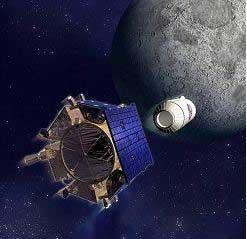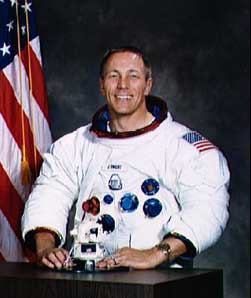
Managed and operated by NASA Ames Research Center working in conjunction with spacecraft and integration partner Northrop Grumman and launch partner United Launch Alliance, LCROSS sought to confirm the presence of water ice in a permanently shadowed crater near a lunar polar region. Concentrated hydrogen signatures had been detected in that area in 1999 by NASA's Lunar Prospector. LCROSS employed the unusual technique of crashing a spacecraft into the Moon in order to observe and analyze the resulting debris plume created by the impact.
"For decades, scientists believed the Moon to be dry and devoid of life," said Space Foundation Chief Executive Officer Elliot Pulham. "But, now, thanks to LCROSS, we have a completely different perspective - one that could lead to further exploration and discovery."
Pulham said that the confirmation of water ice was part of the reason LCROSS was selected for the Swigert Award, but not the entire rationale. "We were impressed with the way LCROSS leveraged both civil and commercial assets into a relatively low-cost, fast-turnaround project. Big bang - both figuratively and literally - for relatively little bucks."
Launched together with the Lunar Reconnaissance Orbiter (LRO) aboard an Atlas V rocket in June 2009, LCROSS was part of the Lunar Precursor Robotic Program, one of the first American missions to the Moon in over ten years. Holding on to a Centaur upper stage booster rocket, the LCROSS shepherding spacecraft orbited the Earth and Moon for several months to achieve the mission's optimal impact angle, which was important to accomplish the largest debris plume possible. Plus, the long orbit depleted the spacecraft's fuel supply to prevent lunar contamination. On October 9, 2009, the Centaur rocket separated from the LCROSS sheparding spacecraft and crashed into the Cabeus crater near the south pole of the Moon. Following four minutes behind the Centaur, the LCROSS shepherding spacecraft passed through the resulting debris plume, collecting and relaying data until it also crashed into the crater. Using spectrometers, cameras, and a radiometer, LCROSS captured data of the debris plume as it encountered sunlight, which causes water-ice, hydrocarbons, or organics to vaporize and break down into their basic components. In November 2009, NASA scientists confirmed that the plume did, indeed, contain water ice - in larger amounts than originally suspected. This is an important finding that could influence future lunar exploration.

Portrait of Swigert. Photo: NASA

